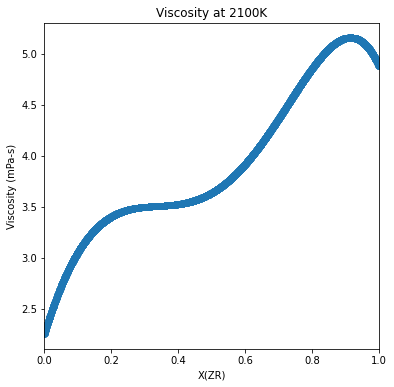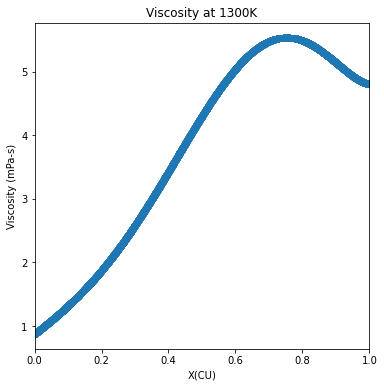Custom Models in pycalphad: Viscosity¶
Viscosity Model Background¶
We are going to take a CALPHAD-based property model from the literature and use it to predict the viscosity of Al-Cu-Zr liquids.
For a binary alloy liquid under small undercooling, Gąsior suggested an entropy model of the form
where \(\eta_i\) is the viscosity of the element \(i\), \(x_i\) is the mole fraction, \(S_{ex}\) is the excess entropy, and \(R\) is the gas constant.
For more details on this model, see
M.E. Trybula, T. Gancarz, W. Gąsior, Density, surface tension and viscosity of liquid binary Al-Zn and ternary Al-Li-Zn alloys, Fluid Phase Equilibria 421 (2016) 39-48, doi:10.1016/j.fluid.2016.03.013.
Władysław Gąsior, Viscosity modeling of binary alloys: Comparative studies, Calphad 44 (2014) 119-128, doi:10.1016/j.calphad.2013.10.007.
Chenyang Zhou, Cuiping Guo, Changrong Li, Zhenmin Du, Thermodynamic assessment of the phase equilibria and prediction of glass-forming ability of the Al–Cu–Zr system, Journal of Non-Crystalline Solids 461 (2017) 47-60, doi:10.1016/j.jnoncrysol.2016.09.031.
[1]:
from pycalphad import Database
TDB Parameters¶
We can calculate the excess entropy of the liquid using the Al-Cu-Zr thermodynamic database from Zhou et al.
We add three new parameters to describe the viscosity (in Pa-s) of the pure elements Al, Cu, and Zr:
$ Viscosity test parameters
PARAMETER ETA(LIQUID,AL;0) 2.98150E+02 +0.000281*EXP(12300/(8.3145*T)); 6.00000E+03
N REF:0 !
PARAMETER ETA(LIQUID,CU;0) 2.98150E+02 +0.000657*EXP(21500/(8.3145*T)); 6.00000E+03
N REF:0 !
PARAMETER ETA(LIQUID,ZR;0) 2.98150E+02 +4.74E-3 - 4.97E-6*(T-2128) ; 6.00000E+03
N REF:0 !
Great! However, if we try to load the database now, we will get an error. This is because ETA parameters are not supported by default in pycalphad, so we need to tell pycalphad’s TDB parser that “ETA” should be on the list of supported parameter types.
[2]:
try:
dbf = Database('alcuzr-viscosity.tdb')
except Exception as e:
print(e)
Failed while parsing: PARAMETER ETA(LIQUID,AL;0) 2.98150E+02 +0.000281*EXP(12300/(8.3145*T)); 6.00000E+03 N REF:0
Tokens: None
Expected {{'ELEMENT' W:(-/A-Za-z){1,2} W:(()-/-:A-Z_a-z) Re:('[-+]?([0-9]+\.(?!([0-9]|[eE])))|([0-9]*\.?[0-9]+([eE][-+]?[0-9]+)?)') Re:('[-+]?([0-9]+\.(?!([0-9]|[eE])))|([0-9]*\.?[0-9]+([eE][-+]?[0-9]+)?)') Re:('[-+]?([0-9]+\.(?!([0-9]|[eE])))|([0-9]*\.?[0-9]+([eE][-+]?[0-9]+)?)') LineEnd} | {'SPECIES' W:(*+--9A-Z_a-z) [Suppress:('%')] Group:({{W:(A-Za-z){1,2} [Re:('[-+]?([0-9]+\.(?!([0-9]|[eE])))|([0-9]*\.?[0-9]+([eE][-+]?[0-9]+)?)')]}}...) [Suppress:('/') W:(+-0-9)] LineEnd} | {'TYPE_DEFINITION' Suppress:(<SP><TAB><CR><LF>) !W:( !) SkipTo:(LineEnd)} | {'FUNCTION' W:(()-/-:A-Z_a-z) {{Re:('[-+]?([0-9]+\.(?!([0-9]|[eE])))|([0-9]*\.?[0-9]+([eE][-+]?[0-9]+)?)') | [',']...} {{SkipTo:(';') Suppress:(';') [Suppress:(',')]... [Re:('[-+]?([0-9]+\.(?!([0-9]|[eE])))|([0-9]*\.?[0-9]+([eE][-+]?[0-9]+)?)')] Suppress:([(Yy)])}}... Suppress:([(Nn)])} [Suppress:(W:(-0-:A-Z_a-z))] LineEnd} | {'ASSESSED_SYSTEMS' SkipTo:(LineEnd)} | {'DEFINE_SYSTEM_DEFAULT' SkipTo:(LineEnd)} | {'DEFAULT_COMMAND' SkipTo:(LineEnd)} | {'DATABASE_INFO' SkipTo:(LineEnd)} | {'VERSION_DATE' SkipTo:(LineEnd)} | {'REFERENCE_FILE' SkipTo:(LineEnd)} | {'ADD_REFERENCES' SkipTo:(LineEnd)} | {'LIST_OF_REFERENCES' SkipTo:(LineEnd)} | {'TEMPERATURE_LIMITS' SkipTo:(LineEnd)} | {'PHASE' W:(()-/-:A-Z_a-z) Suppress:(<SP><TAB><CR><LF>) !W:( !) Suppress:(<SP><TAB><CR><LF>) Suppress:(W:(0-9)) Group:({Re:('[-+]?([0-9]+\.(?!([0-9]|[eE])))|([0-9]*\.?[0-9]+([eE][-+]?[0-9]+)?)')}...) Suppress:(SkipTo:(LineEnd))} | {'CONSTITUENT' W:(()-/-:A-Z_a-z) Suppress:(<SP><TAB><CR><LF>) Suppress:(':') Group:(Group:({{[Suppress:(',')] W:(*+--9A-Z_a-z) [Suppress:('%')]}}...) [: Group:({{[Suppress:(',')] W:(*+--9A-Z_a-z) [Suppress:('%')]}}...)]...) Suppress:(':') LineEnd} | {'PARAMETER' {'BMAGN' | 'DF' | 'DQ' | 'ELRS' | 'G' | 'GD' | 'L' | 'MF' | 'MQ' | 'NT' | 'SIGM' | 'TC' | 'THCD' | 'THETA' | 'V0' | 'VA' | 'VC' | 'VISC' | 'VK' | 'VS' | 'XI'} Suppress:('(') W:(()-/-:A-Z_a-z) [Suppress:('&') W:(-/A-Za-z){1,2}] Suppress:(',') Group:(Group:({{[Suppress:(',')] W:(*+--9A-Z_a-z) [Suppress:('%')]}}...) [: Group:({{[Suppress:(',')] W:(*+--9A-Z_a-z) [Suppress:('%')]}}...)]...) [Suppress:(';') W:(0-9)] Suppress:(')') {{Re:('[-+]?([0-9]+\.(?!([0-9]|[eE])))|([0-9]*\.?[0-9]+([eE][-+]?[0-9]+)?)') | [',']...} {{SkipTo:(';') Suppress:(';') [Suppress:(',')]... [Re:('[-+]?([0-9]+\.(?!([0-9]|[eE])))|([0-9]*\.?[0-9]+([eE][-+]?[0-9]+)?)')] Suppress:([(Yy)])}}... Suppress:([(Nn)])} [Suppress:(W:(-0-:A-Z_a-z))] LineEnd} | {'ZEROVOLUME_SPECIES' SkipTo:(LineEnd)} | {'DIFFUSION' SkipTo:(LineEnd)}}, found '(' (at char 17), (line:1, col:18)
Adding the ETA parameter to the TDB parser¶
[3]:
import pycalphad.io.tdb_keywords
pycalphad.io.tdb_keywords.TDB_PARAM_TYPES.append('ETA')
Now the database will load:
[4]:
dbf = Database('alcuzr-viscosity.tdb')
Writing the Custom Viscosity Model¶
Now that we have our ETA parameters in the database, we need to write a Model class to tell pycalphad how to compute viscosity. All custom models are subclasses of the pycalphad Model class.
When the ViscosityModel is constructed, the build_phase method is run and we need to construct the viscosity model after doing all the other initialization using a new method build_viscosity. The implementation of build_viscosity needs to do four things:
Query the Database for all the
ETAparametersCompute their weighted sum
Compute the excess entropy of the liquid
Plug all the values into the Gąsior equation and return the result
Since the build_phase method sets the attribute viscosity to the ViscosityModel, we can access the property using viscosity as the output in pycalphad caluclations.
[5]:
from tinydb import where
from pycalphad import Model, variables as v
class ViscosityModel(Model):
def build_phase(self, dbe):
super(ViscosityModel, self).build_phase(dbe)
self.viscosity = self.build_viscosity(dbe)
def build_viscosity(self, dbe):
if self.phase_name != 'LIQUID':
raise ValueError('Viscosity is only defined for LIQUID phase')
phase = dbe.phases[self.phase_name]
param_search = dbe.search
# STEP 1
eta_param_query = (
(where('phase_name') == phase.name) & \
(where('parameter_type') == 'ETA') & \
(where('constituent_array').test(self._array_validity))
)
# STEP 2
eta = self.redlich_kister_sum(phase, param_search, eta_param_query)
# STEP 3
excess_energy = self.GM - self.models['ref'] - self.models['idmix']
#liquid_mod = Model(dbe, self.components, self.phase_name)
## we only want the excess contributions to the entropy
#del liquid_mod.models['ref']
#del liquid_mod.models['idmix']
excess_entropy = -excess_energy.diff(v.T)
ks = 2
# STEP 4
result = eta * (1 - ks * excess_entropy / v.R)
self.eta = eta
return result
Performing Calculations¶
Now we can create an instance of ViscosityModel for the liquid phase using the Database object we created earlier. We can verify this model has a viscosity attribute containing a symbolic expression for the viscosity.
[6]:
mod = ViscosityModel(dbf, ['CU', 'ZR'], 'LIQUID')
print(mod.viscosity)
(0.000657*LIQUID0CU*2.71828182845905**(2585.84400745685*T**(-1.0)) + LIQUID0ZR*(0.00474 - 4.97e-06*(-2128.0 + T)))*(1 + 0.240543628600637*(LIQUID0CU*LIQUID0ZR*(392.8485 - 51.3121*log(T)) + (LIQUID0CU - LIQUID0ZR)*LIQUID0CU*LIQUID0ZR*(75.3798 - 9.6125*log(T)) + (LIQUID0CU - LIQUID0ZR)**2*LIQUID0CU*LIQUID0ZR*(-270.5305 + 36.8512*log(T)) + (LIQUID0CU - LIQUID0ZR)**3*LIQUID0CU*LIQUID0ZR*(105.895 - 13.6488*log(T)))/(LIQUID0CU + LIQUID0ZR))
Finally we calculate and plot the viscosity.
[7]:
%matplotlib inline
import matplotlib.pyplot as plt
import numpy as np
from pycalphad import calculate
mod = ViscosityModel(dbf, ['CU', 'ZR'], 'LIQUID')
temp = 2100
# NOTICE: we need to tell pycalphad about our model for this phase
models = {'LIQUID': mod}
res = calculate(dbf, ['CU', 'ZR'], 'LIQUID', P=101325, T=temp, model=models, output='viscosity')
fig = plt.figure(figsize=(6,6))
ax = fig.gca()
ax.scatter(res.X.sel(component='ZR'), 1000 * res.viscosity.values)
ax.set_xlabel('X(ZR)')
ax.set_ylabel('Viscosity (mPa-s)')
ax.set_xlim((0,1))
ax.set_title('Viscosity at {}K'.format(temp));

We repeat the calculation for Al-Cu.
[8]:
%matplotlib inline
import matplotlib.pyplot as plt
import numpy as np
from pycalphad import calculate
temp = 1300
models = {'LIQUID': ViscosityModel} # we can also use Model class
res = calculate(dbf, ['CU', 'AL'], 'LIQUID', P=101325, T=temp, model=models, output='viscosity')
fig = plt.figure(figsize=(6,6))
ax = fig.gca()
ax.scatter(res.X.sel(component='CU'), 1000 * res.viscosity.values)
ax.set_xlabel('X(CU)')
ax.set_ylabel('Viscosity (mPa-s)')
ax.set_xlim((0,1))
ax.set_title('Viscosity at {}K'.format(temp));
